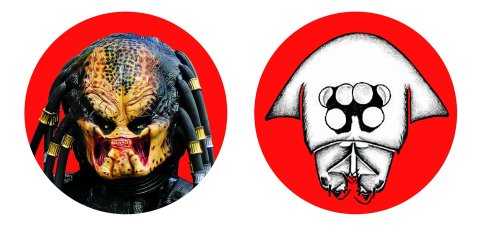
In the 1987 movie Predator, an alien stalks a team of Special Forces commandos, led by "Dutch" (Arnold Schwarzenegger), who cuts vines and sharpens sticks to build traps and take down the titular creature.
Some of Dutch's techniques were recently adopted by a group of scientists, who happen to be fans of the film. They were in pursuit of a real-life predator, a new genus of goblin spider, which, like Dutch's band of extraterrestrial hunting soldiers, fiercely dominate their ecosystems. Instead of snare traps and miniguns, the scientists set pitfall traps: PVC tubes filled with a mix of formalin preservative and detergent. They buried the traps just below the surface of the soil.
The tiny spiders—at 2-millimeter they are as along as a nickel is thick—move through the dirt, beneath the leaves that cover the forest floor. As they stalked their prey—mainly springtails and booklice—they would tumble into the pipes. The scientists later collected the dead specimens and used an artificial digestive enzyme to reveal internal soft tissue before analysis.
As if this imitation of the movie weren't flattery enough, the scientists later dubbed the genus of goblin spiders Predatoroonops, after the alien. "We named the genus and the species in honor of the participants and the peculiarities of the film," says Antonio Brescovit, an arachnologist with the Butantan Institute of São Paulo, who coordinated the survey of the forests.
The spiders are part of a tradition of science adopting pop culture names, including the Matt Groening crab, the Kate Winslet beetle, the Frank Zappa snail, the Dolly Parton lichen and a bee and a jellyfish named for Sheldon Cooper's Big Bang Theory catchphrase, "Bazinga." The goblin spider P. schwarzeneggeri isn't even the first species named for Arnold; there's a beetle with beefy arms (Agra schwarzeneggeri), as well as a minuscule fly that has unusually large forelegs (Megapropodiphora arnoldi).
Brescovit and his team got the naming idea when they noticed the goblin spider's physical resemblance to the Predator alien. Examining the spiders through an LEO 1450VP scanning electron microscope, they spotted tarsal claws at the tip of their legs and fanged appendages—or chelicera—hanging in front of their mouths.
In all, the team collected 29 specimens, including 17 new species of the Predatoroonops spiders. Predatoroonops dutch is named for Schwarzenegger's role, and Predatoroonops dillon for the Carl Weathers character, who Dutch says has been "pushing too many pencils" for the CIA. Others bear the names of director John McTiernan (P. mctiernani), the fictional country where Predator takes place (P. valverde) and the nickname Val Verde natives gave the "demon who makes trophies of men" (P. olddemon). "I looked at the film about 10 times, to ensure that the nomenclature was correct and that all were honored," says Brescovit, who is as fastidious with his pop culture references as he is with his electron microscopy.

Brescovit described the discovery in the June 2012 issue of the Bulletin of the American Museum of Natural History. In between descriptions of microscopic structures separating one Predatoroonops from another (it takes a combination of chelicera and genital structures to distinguish a P. billy from a P. peterhalli, named for the actor inside the Predator suit), Brescovit and his colleagues include notes describing the inspiring character: P. blain "refers to Blain Cooper, played by Jesse Ventura in the original Predator; he often chews tobacco and wears a battered, old slouch hat."
There was another reason behind the choice of names: A little Hollywood glamour might help raise awareness for forgotten and threatened species that live in jungles. "It shows how little we know of the fauna that inhabits the forest litter," says Brescovit. "The destruction of these forests can help to extinguish small species and increase the loss of diversity. Like the species of this genus of spiders, there are millions of others, of several taxons, suffering the same danger, without being described for science."
The process of naming has always had power, whether religious, as in the word that creates the world, or in its ability to create a legend, like the giant squid of sailors' nightmares. With six movies in the Predator series (the latest opened on September 14), we now understand the fictional beast better than its real-life namesake, living only a few miles from São Paulo, one of the biggest cities in the Western Hemisphere.
"Almost nothing is known about the biology of Predatoroonops," Brescovit says, "and they are difficult to keep in captivity." In that way too, the goblin spiders are just like their namesake.















